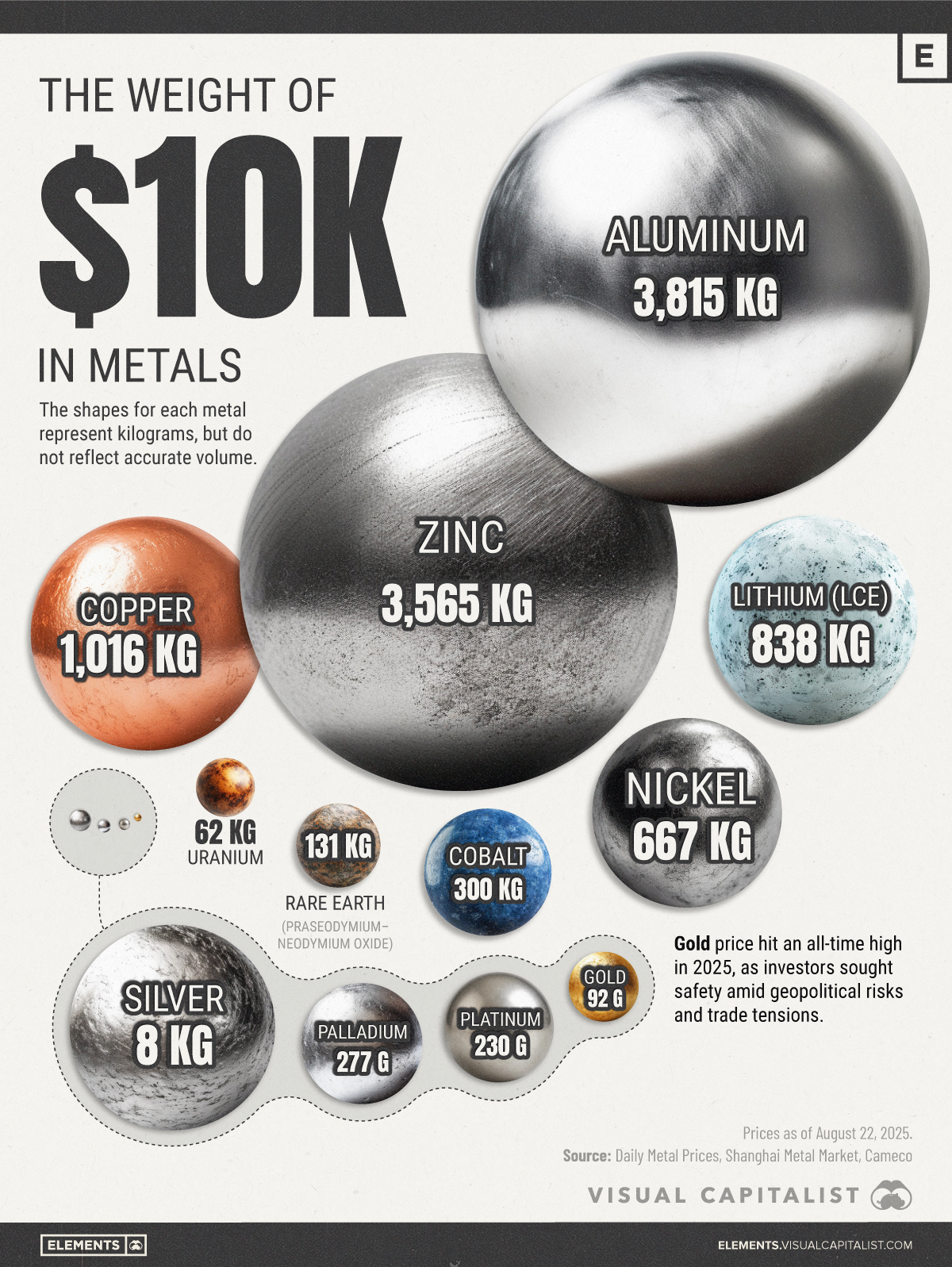![]()
See this visualization first on the Voronoi app.

Use This Visualization
How Much Metal Can $10K Buy?
This was originally posted on our Voronoi app. Download the app for free on iOS or Android and discover incredible data-driven charts from a variety of trusted sources.
Key Takeaways
- $10,000 buys just 92 grams of gold but over 3,800 kg of aluminum.
- The chart highlights the stark value-to-weight differences between precious and industrial metals.
The prices of metals reflect a contrast between rarity, utility, and value. This visualization breaks down how much of each metal you could purchase with $10,000, showing their respective weights in kilograms.
At one end of the scale, $10,000 barely buys a handful of gold dust. On the other, it secures literal tons of industrial metals like aluminum and zinc. The data for this visualization comes from Daily Metal Prices.
Precious Metals: Small in Size, Big in Value
Gold tops the chart in value, costing over $108 million per metric ton. That means $10,000 only gets you 92 grams, barely more than a chocolate bar.
| Metal | Price per Ton (USD) | $10K Buys (Metric Tons) | Kilograms (kg) equivalent |
|---|---|---|---|
| Gold | 108,420,000 | 0.0000923 | 92 g |
| Platinum | 43,440,000 | 0.00023 | 230 g |
| Palladium | 36,060,000 | 0.000277 | 277 g |
| Silver | 1,250,000 | 0.008 | 8.0 kg |
| Uranium | 161,488 | 0.0619 | 61.9 kg |
| Rare Earth (Pr–Nd Oxide) | 76,506 | 0.131 | 131 kg |
| Cobalt | 33,335 | 0.3 | 300 kg |
| Nickel | 15,005 | 0.667 | 667 kg |
| Lithium (LCE) | 11,934 | 0.838 | 838 kg |
| Copper | 9,838 | 1.016 | 1,016 kg |
| Zinc | 2,807 | 3.565 | 3,565 kg |
| Aluminum | 2,622 | 3.815 | 3,815 kg |
Platinum and palladium are slightly less expensive but still highly valuable, offering just a few hundred grams per $10,000. These metals are prized for their rarity, beauty, and industrial applications, especially in electronics and catalytic converters.
Industrial Metals: Value in Volume
On the opposite end are base metals like aluminum, zinc, and copper. These materials are far more abundant and are critical to infrastructure and manufacturing. For example, with $10,000, you could buy 3,815 kilograms of aluminum, enough to construct dozens of bicycles. Even copper, a more valuable industrial metal, yields over a metric ton for the same amount of money.
Strategic and Emerging Materials
In between are metals like lithium and nickel, which are crucial to green technologies, batteries, and energy systems. Lithium, priced at nearly $12,000 per ton, yields 838 kg for $10,000, while nickel provides 667 kg.
Learn More on the Voronoi App ![]()
If you enjoyed today’s post, check out Charted: Where the U.S. Gets Its Rare Earths From on Voronoi, the new app from Visual Capitalist.